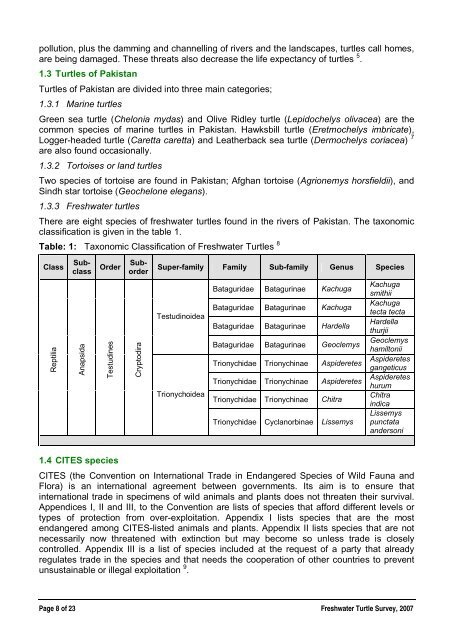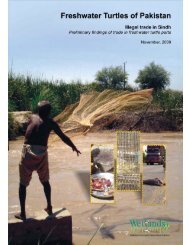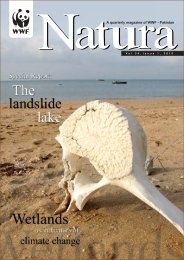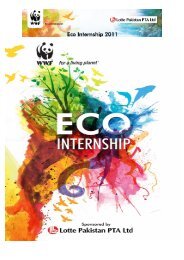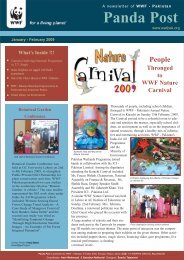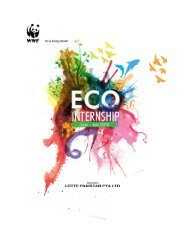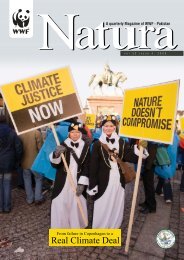Freshwater Turtles of Pakistan
Freshwater Turtles of Pakistan2-2007 - WWF-Pakistan
Freshwater Turtles of Pakistan2-2007 - WWF-Pakistan
You also want an ePaper? Increase the reach of your titles
YUMPU automatically turns print PDFs into web optimized ePapers that Google loves.
pollution, plus the damming and channelling <strong>of</strong> rivers and the landscapes, turtles call homes,<br />
are being damaged. These threats also decrease the life expectancy <strong>of</strong> turtles 5 .<br />
1.3 <strong>Turtles</strong> <strong>of</strong> <strong>Pakistan</strong><br />
<strong>Turtles</strong> <strong>of</strong> <strong>Pakistan</strong> are divided into three main categories;<br />
1.3.1 Marine turtles<br />
Green sea turtle (Chelonia mydas) and Olive Ridley turtle (Lepidochelys olivacea) are the<br />
common species <strong>of</strong> marine turtles in <strong>Pakistan</strong>. Hawksbill turtle (Eretmochelys imbricate),<br />
Logger-headed turtle (Caretta caretta) and Leatherback sea turtle (Dermochelys coriacea) 7<br />
are also found occasionally.<br />
1.3.2 Tortoises or land turtles<br />
Two species <strong>of</strong> tortoise are found in <strong>Pakistan</strong>; Afghan tortoise (Agrionemys horsfieldii), and<br />
Sindh star tortoise (Geochelone elegans).<br />
1.3.3 <strong>Freshwater</strong> turtles<br />
There are eight species <strong>of</strong> freshwater turtles found in the rivers <strong>of</strong> <strong>Pakistan</strong>. The taxonomic<br />
classification is given in the table 1.<br />
Table: 1: Taxonomic Classification <strong>of</strong> <strong>Freshwater</strong> <strong>Turtles</strong> 8<br />
Class<br />
Reptilia<br />
Subclass<br />
Order Suborder<br />
Anapsida<br />
Testudines<br />
Cryptodira<br />
Super-family Family Sub-family Genus Species<br />
Testudinoidea<br />
Trionychoidea<br />
Bataguridae Batagurinae Kachuga<br />
Bataguridae Batagurinae Kachuga<br />
Bataguridae Batagurinae Hardella<br />
Bataguridae Batagurinae Geoclemys<br />
Trionychidae Trionychinae Aspideretes<br />
Trionychidae Trionychinae Aspideretes<br />
Trionychidae Trionychinae Chitra<br />
Trionychidae Cyclanorbinae Lissemys<br />
Kachuga<br />
smithii<br />
Kachuga<br />
tecta tecta<br />
Hardella<br />
thurjii<br />
Geoclemys<br />
hamiltonii<br />
Aspideretes<br />
gangeticus<br />
Aspideretes<br />
hurum<br />
Chitra<br />
indica<br />
Lissemys<br />
punctata<br />
andersoni<br />
1.4 CITES species<br />
CITES (the Convention on International Trade in Endangered Species <strong>of</strong> Wild Fauna and<br />
Flora) is an international agreement between governments. Its aim is to ensure that<br />
international trade in specimens <strong>of</strong> wild animals and plants does not threaten their survival.<br />
Appendices I, II and III, to the Convention are lists <strong>of</strong> species that afford different levels or<br />
types <strong>of</strong> protection from over-exploitation. Appendix I lists species that are the most<br />
endangered among CITES-listed animals and plants. Appendix II lists species that are not<br />
necessarily now threatened with extinction but may become so unless trade is closely<br />
controlled. Appendix III is a list <strong>of</strong> species included at the request <strong>of</strong> a party that already<br />
regulates trade in the species and that needs the cooperation <strong>of</strong> other countries to prevent<br />
unsustainable or illegal exploitation 9 .<br />
Page 8 <strong>of</strong> 23 <strong>Freshwater</strong> Turtle Survey, 2007


